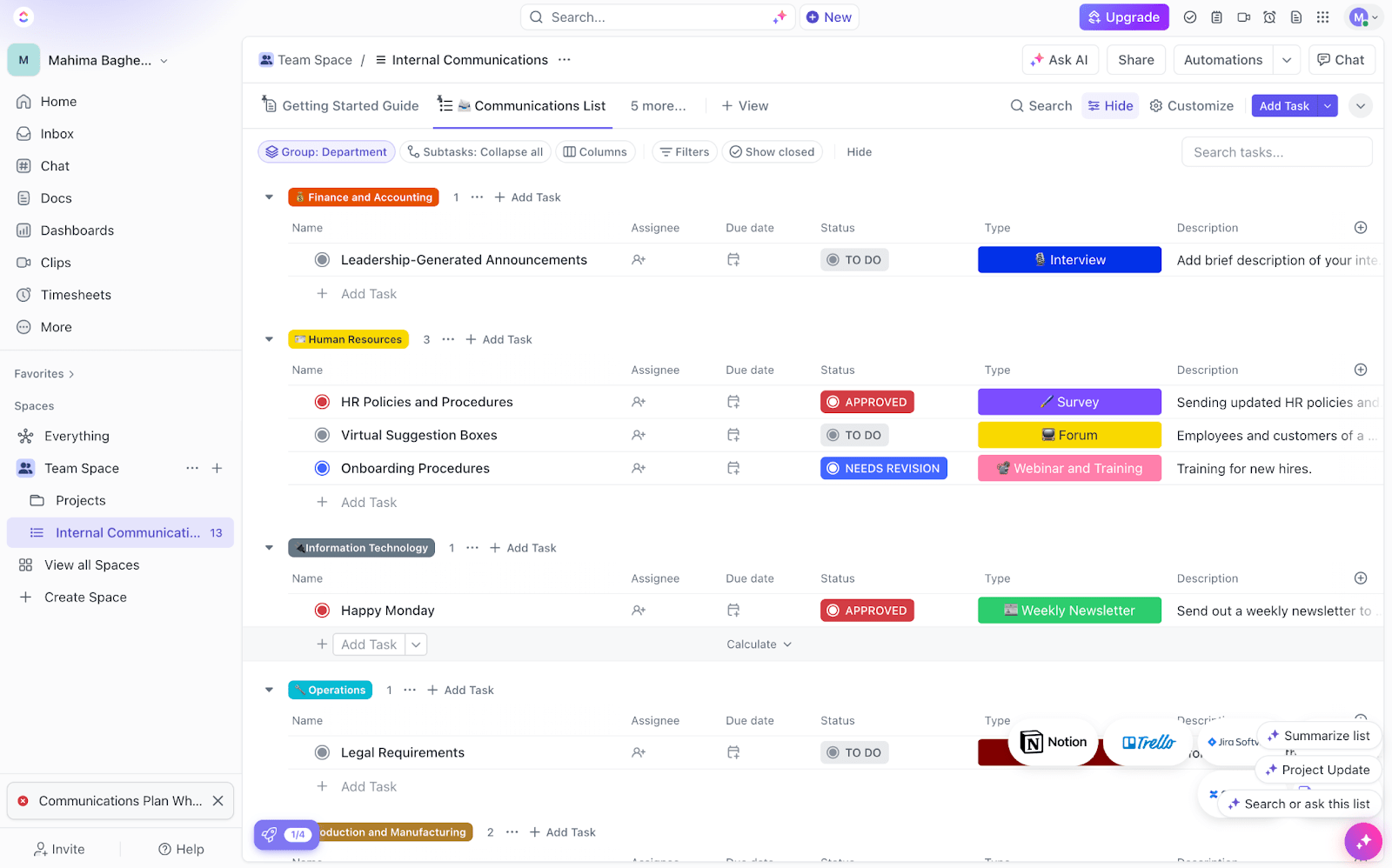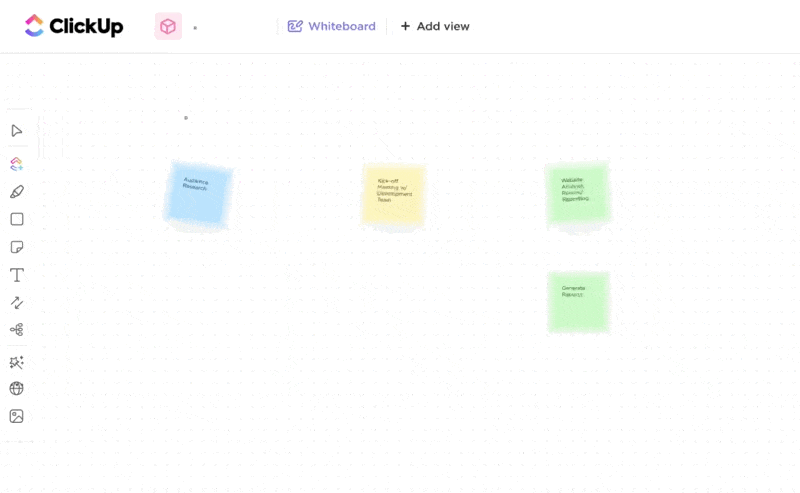تخيل نفسك في سباق تتابع مع الأصدقاء. إن سرعتك في الجري مهمة بالطبع، ولكن النجاح يتوقف إلى حد كبير على تسليم العصا بشكل متزامن.
فكلما كان التنسيق بينكم أكثر سلاسة، كانت فرصكم في الفوز أفضل. يتطلب الوصول إلى هذه النقطة التدريب ووضع الاستراتيجيات والتواصل الواضح بين أعضاء الفريق.
وكما قال تشارلز داروين في التاريخ الطويل للبشرية
(والنوع الحيواني أيضًا) انتصر أولئك الذين تعلموا التعاون والارتجال بفعالية أكبر
التعاون أمر بالغ الأهمية في مجال الأعمال التجارية أيضًا. وفي حين أن توحيد الجهود يمكن أن يعزز الأرباح، فإن درجة النجاح تعتمد على مدى فعالية التعاون.
ينطوي تحسين التعاون في مجال الأعمال على تبني العقلية والأدوات الصحيحة. دعنا نستكشف المزيد.
ما هو التعاون في الأعمال؟
يشير التعاون في مجال الأعمال إلى عملية عمل فردين أو أكثر أو فريقين أو منظمتين أو أكثر معًا لتحقيق أهداف مشتركة. وهو ينطوي على مشاركة الموارد والمعرفة والخبرة لحل المشاكل أو الابتكار أو إكمال المشاريع بفعالية أكبر مما يمكن تحقيقه بشكل فردي.
سواء كنت شركة صغيرة أو جزءًا من مؤسسة كبيرة، فإن التعاون في العمل أمر بالغ الأهمية. إنه مفتاح تعزيز النمو وتحسين الإنتاجية والوصول إلى المزيد من العملاء المحتملين عبر جميع قنوات التوزيع.
اقرأ أيضًا: أفضل 10 أدوات تعاون بين الشركات
أنواع التعاون في الأعمال
يمكن أن يتخذ التعاون في الأعمال أشكالاً مختلفة، كل منها يتناسب مع أهداف وهياكل تنظيمية مختلفة.
التعاون الخارجي
التعاون الخارجي هو عندما تتعاون شركة ما مع شركات أخرى أو عملاء أو متعاونين خارجيين للعمل على مشروع أو تحقيق أهداف مشتركة. وهذا يساعد كلا الطرفين من خلال مساعدتهم على تجميع مواردهم وتوسيع أسواقهم.
يسمح هذا النوع من التعاون للشركات بالوصول إلى الموارد المشتركة وتعزيز التعاون الشبكي لحل التحديات المعقدة. ويمكن رؤيته في المشاريع المشتركة أو التحالفات الاستراتيجية أو حتى التعاون المجتمعي مع الشركات المحلية.
📌مثال
إن حملة العلامة التجارية المشتركة بين أوبر وسبوتيفاي . وخلال الحملة، طُلب من الركاب الذين كانوا ينتظرون ركوب أوبر الاتصال بـ Spotify.
وقد أدى الاستماع إلى الموسيقى التي يختارونها إلى الارتقاء بتجربة التنقل للركاب. وفي الوقت نفسه، اكتسبت Spotify إمكانية الوصول إلى المتحولين المحتملين. مكسب للجميع، أي شخص؟
التعاون الداخلي
يحدث التعاون الداخلي داخل الشركة، حيث تعمل الفرق أو الأقسام أو الموظفين الأفراد معًا لتحسين العمليات وتوليد الأفكار وإيجاد حلول للمشاكل.
يعد تعاون الفريق أمرًا حيويًا في مواءمة الجهود والاستفادة من المهارات المتنوعة لدفع المشاريع إلى الأمام بشكل أكثر فعالية.
التحالف الاستراتيجي
يحدث التحالف الاستراتيجي عندما تشكل شركتان أو أكثر شراكة طويلة الأجل لتحقيق منافع مالية أو دخول أسواق جديدة. وهذا نوع رسمي من التعاون التجاري. تتفق الشركات على مشاركة المعرفة أو قنوات التوزيع أو الموارد مع الحفاظ على استقلاليتها.
يمكن أن تساعد التحالفات الاستراتيجية الشركات على الوصول إلى تقنيات جديدة أو عملاء محتملين أو مصالح مماثلة. وهي مفيدة بشكل خاص للشركات التي تسعى إلى تحقيق أهداف محددة تتطلب نقاط قوة تكميلية.
📌مثال حملة "ستراتوس" من جو برو وريد بُل حيث استفادت كلتا العلامتين التجاريتين من تحالف استراتيجي للوصول إلى جمهور أوسع بكثير مما يمكنهما الوصول إليه بشكل فردي. وقد ساعد هذا التعاون الناجح كلا الشركتين على الاستفادة من الأسواق غير المستغلة.
التعاون السحابي
يتضمن التعاون السحابي العمل معًا باستخدام الأدوات والمنصات القائمة على السحابة التي تمكّن أعضاء الفريق، بما في ذلك العاملين عن بُعد، من التعاون بسلاسة.
يستفيد هذا النوع من التعاون من التكنولوجيا السحابية لمشاركة الملفات ومؤتمرات الفيديو وتحرير المستندات في الوقت الفعلي. إنه يجعل من السهل على الفرق البقاء على اتصال وتحسين الإنتاجية.
تساعد أدوات التعاون في تقليل التكاليف التشغيلية وتسهيل التعاون السلس بين المتعاونين الداخليين والخارجيين.
اقرأ أيضًا: التعاون السحابي: الفوائد والتحديات
أنواع أخرى من التعاون في مجال الأعمال
بصرف النظر عن أنواع التعاون التجاري الأربعة المصنفة على نطاق واسع، هناك بعض الأنواع الأخرى التي نناقشها أدناه:
- التعاون المجتمعي: تتعاون الشركات مع المجتمعات المحلية أو العالمية لدعم القضايا أو إنشاء شراكات أو تعزيز التعاون الشبكي
- التعاون بين الشركات الصغيرة: تعمل العديد من الشركات الصغيرة معًا لإيجاد حلول وزيادة المبيعات من خلال الوصول إلى جمهور أكبر من خلال الجهود الجماعية، وغالبًا ما تشكلاستراتيجيات تعاونية مع شركات أخرى في مجتمعهم
- التعاون عبر القطاعات: يتضمن هذا التعاون بين الشركات من مختلف الصناعات التي تجتمع معاً لمواجهة التحديات المعقدة أو توليد أفكار ذات منفعة متبادلة
- التعاون الشبكي: يركز التعاون الشبكي على إنشاء شبكة من العلاقات حيث يساهم المشاركون بمواردهم ومهاراتهم ومعرفتهم المشتركة
أهمية التعاون في مجال الأعمال
لقد أصبح التعاون في مجال الأعمال أمرًا بالغ الأهمية بشكل متزايد. إليك ما يفعله:
- تحفيز الابتكار: التعاون يجمع بين وجهات النظر والخبرات المتنوعة، مما يعزز الإبداع والابتكار.
- يعزز الكفاءة: من خلال تجميع الموارد والمعارف، غالبًا ما تؤدي الجهود التعاونية إلى حل المشاكل وإنجاز المشاريع بكفاءة أكبر.
- تقدم مزايا تنافسية: يمكن للمؤسسات التي تتعاون بفعالية أن تستجيب بسرعة أكبر لتغيرات السوق واحتياجات العملاء.
- تعزز مشاركة المعرفة: يسهل التعاون تبادل الأفكار وأفضل الممارسات، مما يؤدي إلى التعلم والتحسين المستمر.
- يخفف المخاطر: يمكن أن تساعد المسؤوليات المشتركة في المشاريع التعاونية على توزيع المخاطر وتقليلها.
- يعزز قيمة العملاء: غالباً ما يؤدي التعاون إلى منتجات أو خدمات أفضل، مما يعود بالنفع على العميل النهائي في نهاية المطاف.
- يزيد من الانتشار العالمي: يتيح التعاون، خاصة عند الاستفادة من الأدوات الرقمية، للشركات الاستفادة من المواهب والأسواق العالمية.
"6Cs" للتعاون الفعال داخل الفريق
لبناء تعاون ناجح في العمل، يجب أن تضع في اعتبارك هذه "6Cs" للتعاون الفعال.
التواصل
التواصل الواضح والمفتوح هو أساس التعاون الفعال. استخدم أدوات التعاون لضمان قدرة أعضاء الفريق على مشاركة المعرفة ومناقشة الأفكار بسهولة.
تستفيد الشركات المعاصرة من العديد من أدوات التعاون في مجال الذكاء الاصطناعي للتعاون الداخلي والخارجي الفعال.
📌مثال: يستخدم فريق تسويق عالمي أدوات ترجمة مدعومة بالذكاء الاصطناعي أثناء مؤتمرات الفيديو للتغلب على الحواجز اللغوية. يضمن ذلك التواصل الواضح والمساهمة المتساوية من أعضاء الفريق في مختلف البلدان.
التنسيق
تحتاج الفرق إلى تنسيق جهودها بكفاءة، ومواءمة المهام مع الأهداف المشتركة. التعاون الفعال في المشروع ضروري للتعاون الداخلي السليم بين الإدارات.
📌مثال: تستخدم شركة تصنيع نظام إدارة مشروع متعدد الوظائف لتنسيق إطلاق منتج جديد. يتيح ذلك للفرق من البحث والتطوير والإنتاج والتسويق والمبيعات تتبع المهام المترابطة والمواءمة مع الجدول الزمني العام للمشروع.
التعاون
الاستعداد للعمل معاً لتحقيق أهداف مشتركة يعزز بيئة تعاونية. يجب أن تفي بجزءك من الصفقة وتفي بواجباتك إذا كنت تريد أن يكون التعاون ناجحًا.
📌 📌مثال: في مشروع مشترك، تتشارك شركة تكنولوجية ناشئة وشركة راسخة في تقنيات الملكية لتطوير منتج جديد. تنشئان فرقًا مختلطة وتضعان بروتوكولات واضحة للتعامل مع المعلومات الحساسة لضمان سلاسة التعاون.
الالتزام
يجب أن يلتزم كل عضو في الفريق بالهدف الجماعي. تعد المشاركة العالية للموظفين أمرًا بالغ الأهمية للحفاظ على التفاني المطلوب للتعاون الفعال في العمل.
📌📌مثال: يتبنى فريق تطوير البرمجيات منهجية رشيقة مع دورات سريعة مدتها أسبوعان. يقوم أعضاء الفريق بتحديد أهداف العدو السريع معًا والالتزام بالمهام الفردية. وهذا يعزز تفانيهم في تحقيق الأهداف المشتركة.
المساهمة
يجب أن يساهم الجميع بمهاراتهم وخبراتهم الفريدة. وفي إطار التعاون، تساهم الشركات والأفراد من مختلف المجالات في توليد الأفكار والحلول معاً.
📌مثال: يشمل مشروع تخطيط مدينة ما مصممي المدن وعلماء البيئة وممثلي المجتمع المحلي وأصحاب الأعمال المحليين. يساهم كل صاحب مصلحة بمنظوره الفريد، مما يؤدي إلى خطة تنمية حضرية شاملة.
أدوات التعاون
إن أدوات التعاون الصحيحة تعزيز الروابط الداخلية والخارجية في التعاون في مجال الأعمال. وتساعد هذه الأدوات على تحقيق العناصر الخمسة الأخرى المذكورة أعلاه.
فهي تعزز التواصل والتنسيق والتعاون. تساعد الأدوات التعاونية أيضًا في تجنب التصادمات من خلال تتبع المهام المعينة والتحديثات مع ضمان التزام الأشخاص بالجداول الزمنية الملتزم بها.
📌مثال: تستخدم إحدى الشركات الاستشارية منصة مساحة عمل رقمية تدمج ميزات إدارة المشاريع ومشاركة المستندات والتواصل. يتيح ذلك للاستشاريين عبر مناطق زمنية مختلفة التعاون بسلاسة في مشاريع العملاء.
كيفية بناء علاقات تعاونية في الأعمال التجارية
بناء علاقات تعاونية قوية أمر ضروري لنجاح الأعمال في عالم اليوم المترابط.
وتقع أدوات التعاون في مركز علاقات التعاون في الأعمال التجارية. أدوات التعاون الحديثة مثل ClickUp تسهيل السلاسة التعاون متعدد الوظائف الذي يرتقي بوظائف العمل بشكل عام . حلول بونتيكا وهي شركة سريعة النمو في مجال تعهيد العمليات التجارية (BPO) وتعهيد تكنولوجيا المعلومات (ITO) مع فرق عمل يصل عدد أفرادها إلى 200 شخص، اختبرت العديد من أدوات إدارة المشاريع والتعاون. وفي النهاية، اختاروا ClickUp.
_ لقد أدركت أننا بالتأكيد كنا بحاجة إلى ClickUp - لقد كان اختيارًا لا يحتاج إلى تفكير، حيث يمكن لفريقنا الآن العمل على نفس المشروع معًا والتواصل مع أي صاحب مصلحة على الفور أينما كان
دايانا ميليفا، مديرة حسابات في بونتيكا.
دعنا ندرس بعض الاستراتيجيات الرئيسية لإنشاء علاقات تعاونية ناجحة ودعمها. سندرس أيضًا كيفية استخدام أدوات التعاون الحديثة مثل ClickUp لتسهيل هذه العمليات.
1. تحديد الأهداف والغايات
حدد بوضوح أهداف التعاون. حدد ما تهدف إلى تحقيقه. هل هو دخول أسواق جديدة؟ تحسين الموارد؟ تطوير منتجات مبتكرة؟ إن التوافق على الأهداف المشتركة يمهد الطريق لشراكة مثمرة. مستندات ClickUp دورًا حيويًا هنا. فهو يتيح للفرق إنشاء مستندات حية ومشاركتها.
من خلال التعاون في الوقت الفعلي، يمكن لأعضاء الفريق المتعددين:
- التحرير في وقت واحد بينما يتتبع سجل الإصدارات التغييرات والمساهمات
- دمج المهام والمشاريع لضمان سير العمل بسلاسة من التخطيط إلى التنفيذ
- مشاركة التعليقات أثناء وضع علامات على بعضها البعض لتشجيع التواصل والتعليقات السريعة
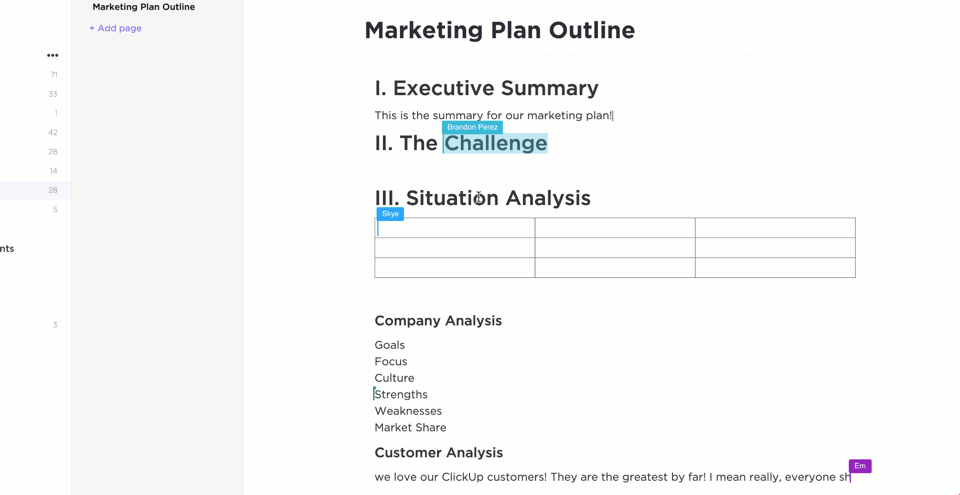
تعاون على المستندات مع فريقك على ClickUp Docs
يتميز ClickUp Docs أيضًا بما يلي اكتشاف التعاون الذي ينبه أعضاء الفريق عندما يعمل الآخرون على نفس المستند. وهذا يمنع التعارضات ويحمي التعاون في الوقت الفعلي.
مواءمة المهام مع الأهداف
بمجرد تحديد الأهداف، من المهم وضعها في خطط قابلة للتنفيذ. مهام النقر فوق المهام دورًا حاسمًا في التواصل الواضح من خلال توفير منصة مركزية لتعيين العمل وتتبعه ومناقشته.
يمكن للفرق:
- إنشاء المهام وتعيينها وتحديد أولوياتها
- تحديد تواريخ الاستحقاق
- إضافة أوصاف وتعليقات مفصلة
يمكنك أيضًا استخدام نماذج اتفاقية التعاون لتحديد أهداف واضحة .
على سبيل المثال، قم بتحديد الأهداف وتتبعها لكل مشروع وفريق باستخدام قالب الاتصالات الداخلية في ClickUp . استخدمه لقياس التقدم المحرز نحو تحقيق الأهداف، وضمان المواءمة بين الفرق وتعزيز الالتزام بالأهداف المشتركة.
تتبع التقدم المحرز في المهام باستخدام قالب الاتصالات الداخلية من ClickUp
يقدم هذا القالب:
- قوائم مهام معدة مسبقًا لأنواع مختلفة من الاتصالات الداخلية
- حقول مخصصة لتتبع حالة الرسالة والجمهور المستهدف وقنوات التواصل
- لوحة معلومات لتصور مقاييس التواصل والتقدم المحرز في التواصل
- التكامل مع ميزات إدارة المهام في ClickUp لسير عمل سلس
2. تواصل واضح
التواصل هو جانب رئيسي من جوانب التعاون. لذا، تذكر أن تختار قنوات التواصل مع فريقك بحكمة.
من الصعب الحفاظ على التركيز والتنظيم عندما تكون محادثاتك في مكان وعملك في مكان آخر.
وهنا يأتي دور دردشة ClickUp يأتي في. من خلال جمع مناقشاتك ومهامك في منصة واحدة موحّدة، يضمن لك تطبيق كل شيء هذا دمج كل ما تحتاجه للتواصل والتعاون بسلاسة. يؤدي ذلك إلى إنتاجية أفضل، وتواصل أوضح، وسير عمل أكثر تركيزًا - كل ذلك دون الحاجة إلى التبديل بين التطبيقات.
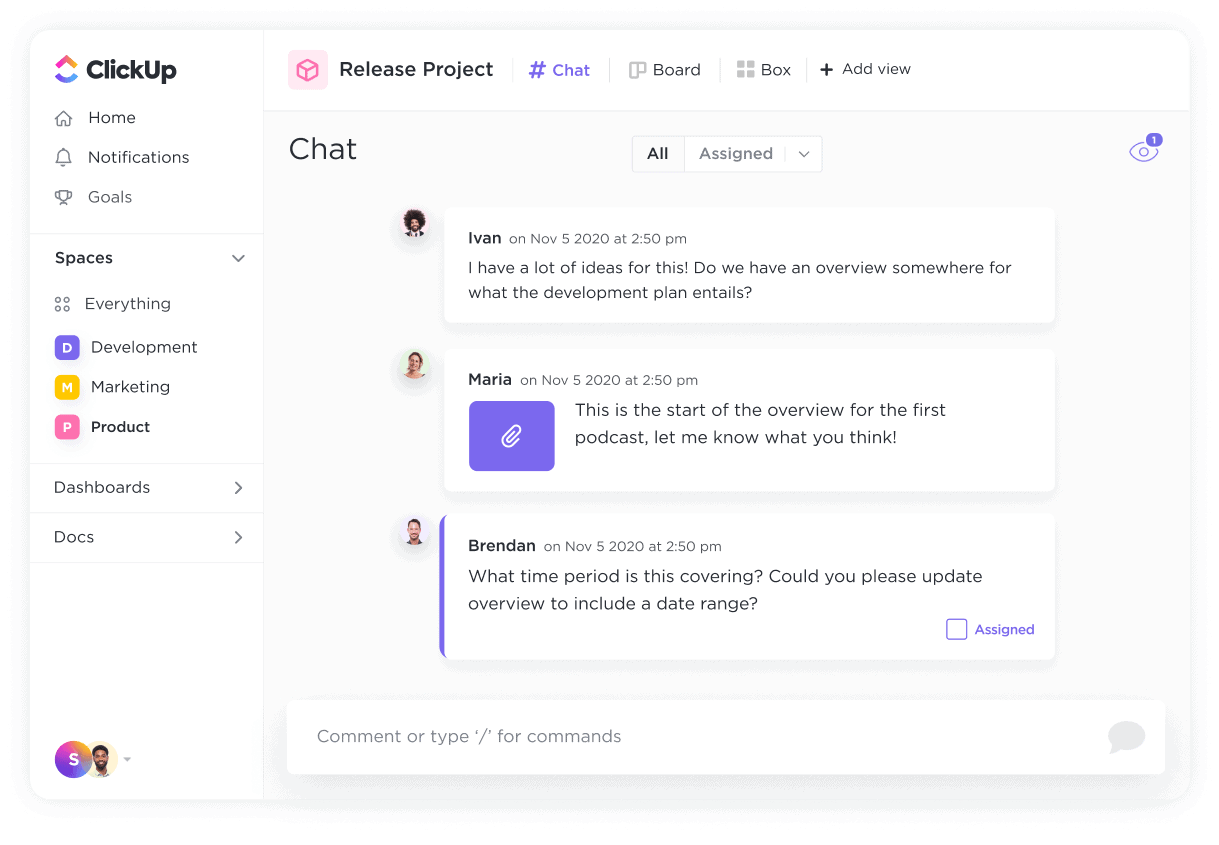
أطلق العنان لتواصل وتعاون لا مثيل لهما مع ClickUp Chat
يساعد هذا التكامل السلس بين التواصل وإدارة المهام فرق العمل على الحفاظ على التوافق والإنتاجية.
يستخدم ClickUp Chat الذكاء الاصطناعي لتعزيز إنتاجيتك من خلال الإجابة عن الأسئلة تلقائياً استناداً إلى سجل الدردشة ومعلومات مساحة العمل.
تشمل الميزات الرئيسية ما يلي:
- المراسلة في الوقت الفعلي: تمكين المحادثات السريعة حول المهام، وتقليل التأخير وتعزيز التعاون الفوري
- المحادثات المرتبطة بالمهام: إبقاء المناقشات ذات صلة ومنظمة، مما يسمح لأعضاء الفريق بالرجوع إلى مهام محددة بسهولة
- تعيين المهام: تعيين المهام: تعيين المهام مباشرةً من الدردشة لتبسيط سير العمل وضمان المساءلة
- المحادثات المترابطة: ينظم المناقشات، مما يسهل متابعة مواضيع محددة والرد عليها دون التباس
- تنبيهات مركزية: حافظ على تركيز المستخدمين من خلال دمج التنبيهات داخل النظام الأساسي، مما يقلل من تشتيت الانتباه
قوالب اتصالات معدة مسبقًا، وإشعارات تلقائية، وإدارة بريد إلكتروني متكاملة - كل هذا يمكن أن يعزز فعالية تعاون فريقك مع فريقك .
3. تحديد الشركاء المحتملين ووضع شروط واضحة
ابحث عن الشركات التي تكمل نقاط قوتك وتشترك معك في قيم أو اهتمامات مماثلة، مع التركيز على الشركاء المحتملين الذين يعززون الروابط الداخلية والخارجية.
بمجرد العثور على شركاء محتملين، ضع شروطًا واضحة تحدد الأدوار والمسؤوليات وتخصيص الموارد لتعزيز الشفافية والثقة.
إن الخرائط الذهنية لـ ClickUp مفيدة للغاية هنا. فهي تسمح للفرق بإجراء عصف ذهني بصري وتخطيط الشراكات والأدوار والمسؤوليات المحتملة.
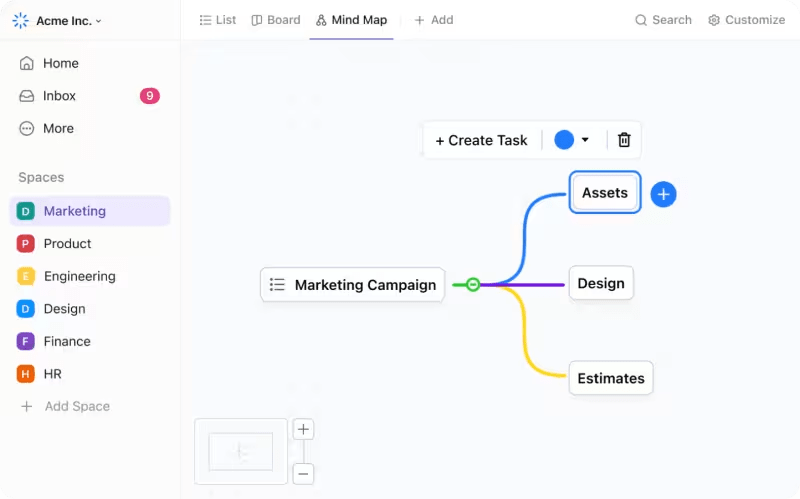
تخطيط سير العمل باستخدام الخرائط الذهنية ClickUp Mind Maps
يمكن أن يساعد هذا النهج المرئي في تحديد أوجه التآزر والتحديات المحتملة في العلاقات التعاونية قبل أن تتشكل بالكامل.
إن قالب مصفوفة اتصالات فريق ClickUp ومصفوفة الاجتماعات يمكن أن يساعد أيضًا. فهو ينظم قنوات الاتصال وجداول الاجتماعات بكفاءة عبر مختلف الفرق أو الشركاء.
4. رصد وتقييم التقدم المحرز والاحتفال بالنجاحات
رصد وتقييم فعالية التعاون بانتظام مقابل الأهداف المحددة، وإجراء التعديلات اللازمة حسب الحاجة.
الاحتفال بالنجاحات والمعالم البارزة معًا، مما يعزز قيمة الشراكة. يشجع ذلك الأشخاص على الاستمرار في الالتزام بالتعاون ويعزز الروابط الداخلية والخارجية. اللوحات البيضاء لـ ClickUp ممتازة لإنشاء عروض مرئية للتقدم المحرز. فهي تسمح للفرق بـ
- تبادل الأفكار بشكل تعاوني
- إنشاء خرائط طريق مرئية للمشروع
- دمج الخطط المرئية مع المهام القابلة للتنفيذ.

حوّل أفكارك إلى مهام ومشاريع باستخدام ClickUp Whiteboards
تستفيد الفرق الإبداعية من ميزات مثل التدقيق والملاحظات التي تبسّط عملية مراجعة التصميمات ومقاطع الفيديو وتضمن نتائج عالية الجودة.
تعمل ميزة التدقيق في ClickUp على تعزيز التعاون المرئي من خلال السماح لأعضاء الفريق بالتعليق مباشرةً على الصور ومقاطع الفيديو وملفات PDF.
تعمل هذه الميزة على تبسيط عملية الملاحظات للمشاريع المتعلقة بالتصميم، مما يتيح تعليقات دقيقة وملائمة للسياق وتتبع المراجعات والموافقات بكفاءة.
يمكنك أيضًا الاستفادة من السبورة البيضاء لخطة الاتصالات الخاصة ب ClickUp لإنشاء خطة تواصل لفريقك. تساعد هذه الأداة المرئية الفرق على تخطيط وتنفيذ استراتيجيات التواصل الخاصة بهم بشكل أكثر فعالية.
خطط لمناقشات فريقك مع لوحة خطة التواصل من ClickUp
يقدم قالب السبورة البيضاء لخطة الاتصالات من ClickUp:
- تخطيط مرئي لرسم استراتيجيات التواصل
- أقسام لتحديد الجمهور المستهدف والرسائل الأساسية وقنوات الاتصال
- التكامل مع مهام ClickUp للمتابعة القابلة للتنفيذ
5. تعزيز الثقة والشفافية من أجل تعاون طويل الأمد
الثقة والشفافية هما مفتاح الحفاظ على العلاقات التعاونية طويلة الأمد. شجع على المشاركة المفتوحة للمعلومات، وكن متسقًا في تصرفاتك، وعزز ثقافة الاحترام المتبادل. مقاطع كليك أب يمكن أن يكون أداة قوية لتعزيز الثقة من خلال التواصل الشفاف. فهو يتيح سهولة تسجيل ومشاركة تسجيلات الشاشة أو مقاطع فيديو كاميرا الويب بسهولة، وإنشاء برامج تعليمية أو شروحات، ومشاركة المعرفة غير المتزامنة.
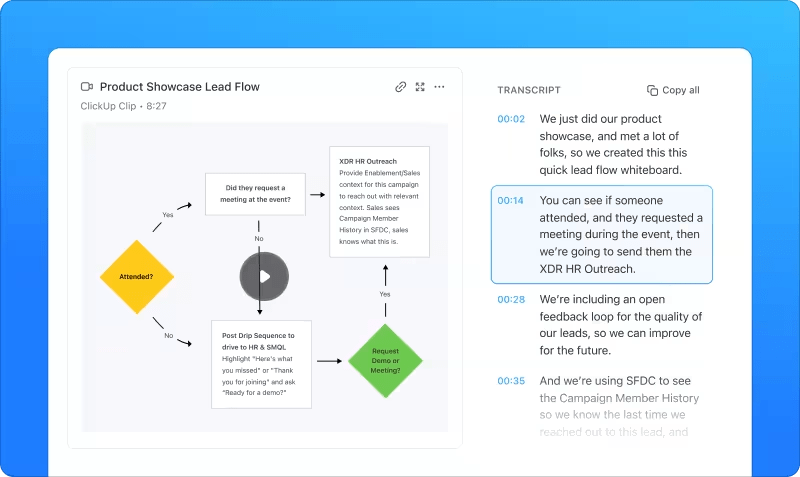
نسخ أي مقطع تلقائيًا باستخدام ClickUp ClickUp Clicks
وهذا يقلل من الحاجة إلى الاجتماعات مع ضمان وصول جميع أعضاء الفريق إلى المعلومات والتحديثات المهمة.
اقرأ أيضًا: 15 نموذجًا مجانيًا لخطة اتصالات المشروع: Excel، وورد، و ClickUp
أفضل الممارسات لتحسين التعاون
لتعظيم فوائد هذه الاستراتيجيات والأدوات، ضع في اعتبارك أفضل الممارسات التالية:
- توفير التدريب الكافي على أدوات التعاون
- تشجيع عمليات تسجيل الوصول المنتظمة وتحديثات الحالة
- تعزيز التوازن بين الاتصالات المتزامنة وغير المتزامنة
- وضع توقعات ومواعيد نهائية واقعية
- تعزيز ثقافة التوثيق
- الاحتفاء بالمكاسب التعاونية والتعلم من الإخفاقات
- السعي باستمرار للحصول على ملاحظات حول عمليات التعاون وتقديمها
- احترام المناطق الزمنية والتوازن بين العمل والحياة في الفرق العالمية
- تشجيع تجربة أساليب التعاون الجديدة
- تقييم مجموعة التعاون الخاصة بك وتحسينها بانتظام
من خلال تنفيذ هذه الاستراتيجيات والاستفادة من الأدوات القوية مثل ClickUp، يمكن للشركات إنشاء أساس قوي للتعاون الفعال، مما يؤدي إلى الابتكار والنجاح في بيئة الأعمال الديناميكية اليوم.
فوائد التعاون في الأعمال وفعاليته ## فوائد التعاون في الأعمال وفعاليته
لا يمكن لأحد أن يصفر سيمفونية. يتطلب الأمر أوركسترا لعزفها_.
H. إي لوكوك
تعمل بعض المشاريع بشكل أفضل عندما تعمل عليها فرق من الأشخاص معًا. التعاون في مكان العمل عند القيام به بشكل فعال، يمكن أن يحقق العديد من الفوائد التي تساهم في نجاح المؤسسة ونموها.
دعونا نستكشف هذه المزايا وكيف يمكن قياسها:
تعزيز الابتكار
- الفائدة: يجمع التعاون بين وجهات النظر المتنوعة، مما يؤدي إلى حلول أكثر إبداعاً وأفكاراً مبتكرة
- _مؤشر الأداء: عدد الأفكار الجديدة التي تم إنشاؤها أو براءات الاختراع المودعة أو إطلاق المنتجات الناجحة
زيادة الإنتاجية: زيادة الإنتاجية
- الفائدة: من خلال مشاركة الموارد والمعرفة، يمكن للفرق إكمال المهام بشكل أكثر كفاءة
- مؤشر الأداء: تقليل وقت إنجاز المشروع وزيادة الإنتاجية لكل موظف
تحسين عملية حل المشكلات
- الفائدة: يساعد الذكاء الجماعي في معالجة التحديات المعقدة بشكل أكثر فعالية
- مؤشر الأداء: تقليل الوقت اللازم لحل المشكلات، وزيادة في حل المشكلات بنجاح
تعزيز مشاركة الموظفين
- الفائدة: يعزز التعاون الشعور بالانتماء والهدف بين أعضاء الفريق
- _مؤشر الأداء: درجات رضا الموظفين، وانخفاض معدلات دوران الموظفين
استخدام أفضل للموارد
- الفائدة: يتيح التعاون استخداماً أكثر كفاءة للمهارات والمعرفة والموارد المادية
- _مؤشر الأداء: تحسين كفاءة تخصيص الموارد، وتقليل العمل الزائد عن الحاجة
زيادة الحصة السوقية: زيادة الحصة السوقية
- الفائدة: يمكن للجهود التعاونية أن تؤدي إلى منتجات وخدمات أفضل، وجذب المزيد من العملاء
- _مؤشر الأداء: نمو الحصة السوقية وزيادة قاعدة العملاء
تخفيض التكلفة
- الفائدة: يمكن أن يؤدي تقاسم الموارد وتجنب ازدواجية الجهود إلى وفورات كبيرة في التكاليف
- مؤشر الأداء: تخفيض التكاليف التشغيلية، وتحسين العائد على الاستثمار في المشاريع
وقت أسرع للوصول إلى السوق
- الفائدة: يمكن أن يؤدي التعاون إلى تبسيط العمليات، مما يقلل من الوقت الذي يستغرقه طرح المنتجات أو الخدمات في السوق
- _مؤشر الأداء: تقليل وقت دورة تطوير المنتجات، وزيادة سرعة تقديم الخدمات
تعزيز التعلّم والتطوير
- الفائدة: يسهل التعاون تبادل المعرفة وتطوير المهارات بين أعضاء الفريق
- مؤشر الأداء: زيادة في مستويات مهارات الموظفين، وخفض تكاليف التدريب
تحسين رضا العملاء: تحسين رضا العملاء
- الفائدة: غالبًا ما تؤدي الجهود التعاونية إلى منتجات وخدمات أفضل، مما يؤدي إلى زيادة رضا العملاء
- مؤشر الأداء: تحسن في درجات رضا العملاء، وزيادة في معدلات الاحتفاظ بالعملاء
السلبيات المحتملة واستراتيجيات التخفيف من حدتها
بينما التعاون في مكان العمل يوفر العديد من الفوائد، من المهم أن تكون على دراية بالتحديات المحتملة وكيفية معالجتها:
التفكير الجماعي
⚠️_التحدي: يمكن أن يؤدي الاتفاق المفرط إلى سوء اتخاذ القرار
✅التخفيف من حدة المشكلة: تشجيع الآراء المتنوعة وتعيين دور محامي الشيطان في المناقشات
تقليل المساءلة الفردية
⚠️التحديالتحدي_: قد لا يتحمل أعضاء الفريق المسؤولية الكاملة عن مهامهم
✅التخفيف من حدة المشكلة: استخدم ميزات تعيين المهام وتتبعها في ClickUp للحفاظ على مسؤوليات فردية واضحة
الإفراط في التواصل
⚠️التحدي: يمكن أن تؤدي كثرة التواصل إلى زيادة عبء المعلومات وانخفاض الإنتاجية
✅التخفيفمنالتحدي_: وضع إرشادات واضحة للتواصل واستخدام إعدادات الإشعارات في ClickUp لإدارة تدفق المعلومات
تضارب الأولويات
⚠️التحدي: قد يكون لأعضاء الفريق أو الأقسام المختلفة أهداف متضاربة
✅التخفيف من حدة المشكلة: استخدم ميزات تحديد الأهداف في ClickUp لمواءمة أهداف الفريق مع الأهداف التنظيمية الشاملة
العمليات المستهلكة للوقت
⚠️التحدي: يمكن أن يؤدي التعاون في بعض الأحيان إلى إبطاء عمليات اتخاذ القرار
✅التخفيفمنالتحدي_: ضع جداول زمنية واضحة للمهام التعاونية واستخدم ميزات تتبع الوقت في ClickUp لمراقبة العمليات وتحسينها
المشاركة غير المتكافئة
⚠️التحدي: قد يهيمن بعض أعضاء الفريق بينما يظل البعض الآخر سلبيًا
✅التخفيفمنالتحدي_: استخدام ميزات توزيع المهام في ClickUp لضمان المشاركة المتوازنة وتناوب الأدوار القيادية بانتظام في المشاريع التعاونية
من خلال إدراك هذه العوائق المحتملة وتنفيذ استراتيجيات التخفيف المناسبة، يمكن للمؤسسات زيادة فوائد التعاون إلى أقصى حد مع تقليل تحدياته.
التعاون بسلاسة وبلا نهاية
التعاون في العمل هو أكثر من مجرد العمل معًا - إنه يتعلق بإيجاد أوجه التآزر التي تؤدي إلى النجاح على المدى الطويل.
من خلال اتباع الاستراتيجيات التي ناقشناها، يمكن للشركات من جميع الأحجام تنمية التعاون الناجح ومواجهة التحديات بكفاءة والازدهار في سوق مترابط.
بينما تشرع في رحلتك لتعزيز التعاون في مؤسستك، فكّر في كيفية دعم مجموعة الميزات الشاملة التي يوفرها ClickUp لجهودك. يوفر ClickUp الأدوات اللازمة لتبسيط التعاون، بدءًا من التعاون في الوقت الفعلي في المستندات إلى التخطيط المرئي للمشروعات وإدارة المهام بكفاءة.
هل أنت مستعد لتحويل إمكانات فريقك التعاونية؟ اشترك في ClickUp اليوم واتخذ الخطوة الأولى نحو مكان عمل أكثر اتصالاً وإنتاجية وابتكارًا.


